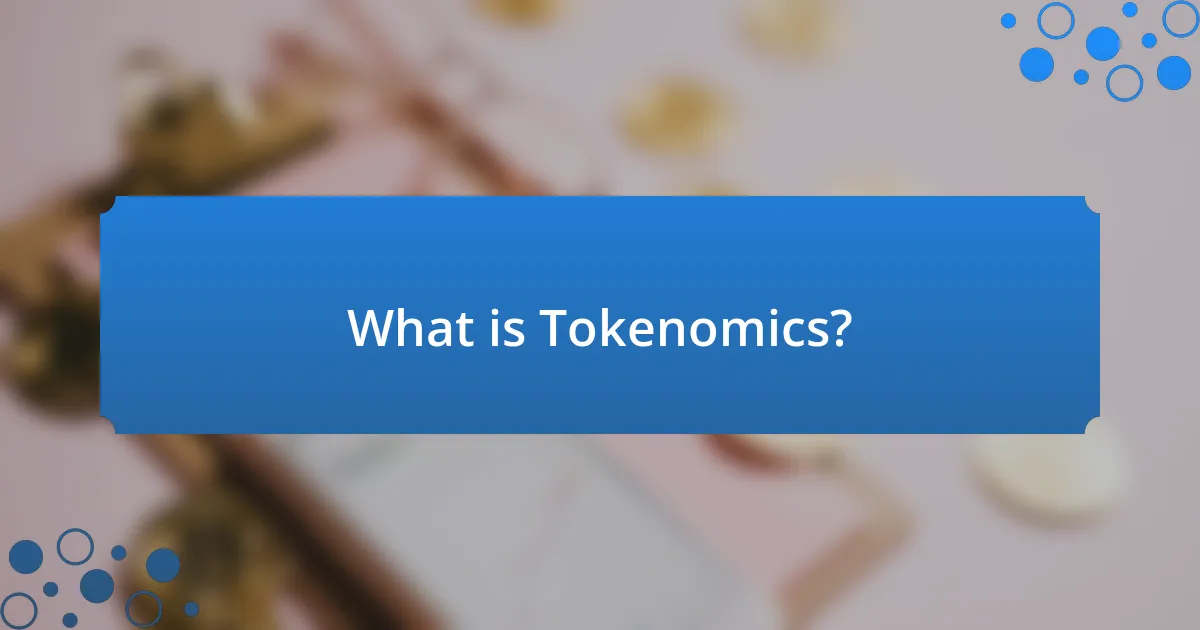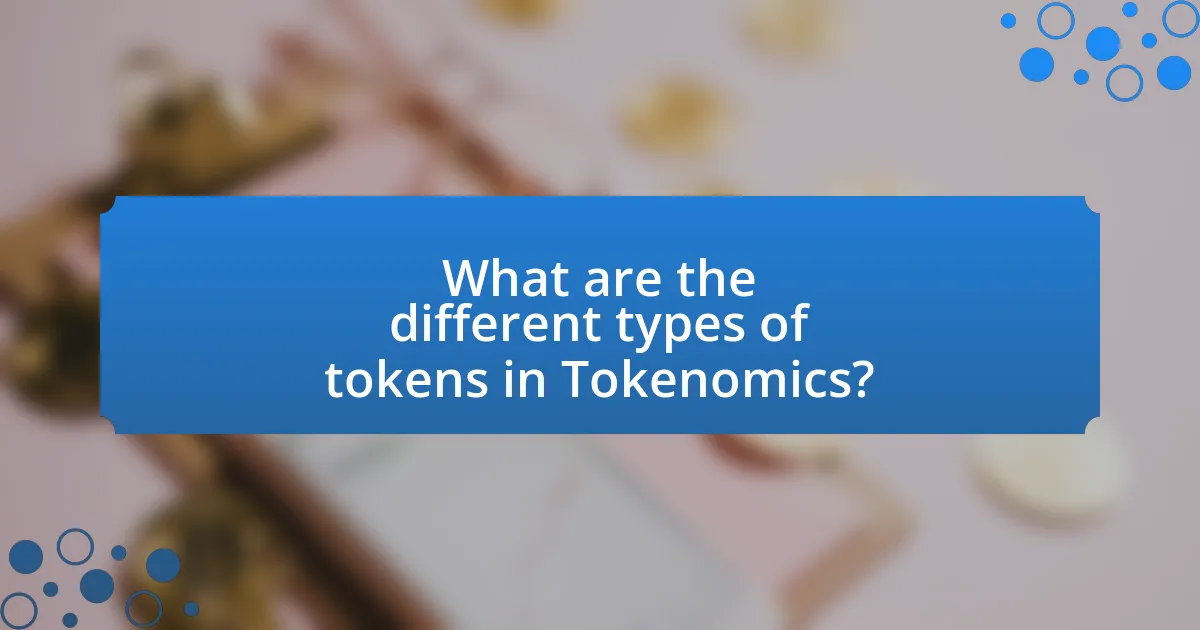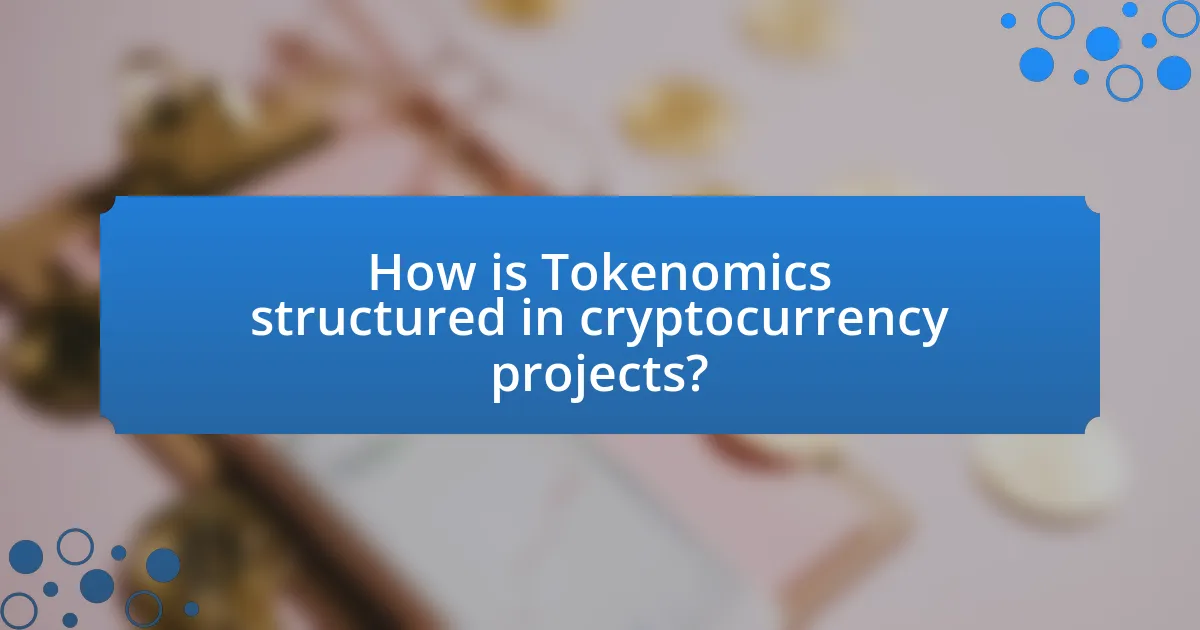Tokenomics is the study of the economic principles and models that govern the creation, distribution, and management of cryptocurrency tokens. This article provides a comprehensive overview of tokenomics, detailing its key components such as supply, demand, utility, and governance, and how these factors influence the value and sustainability of cryptocurrency projects. It also explores the implications of poor tokenomics, the different types of tokens, and the significance of economic incentives, staking, and governance in shaping user behavior and market dynamics. Understanding these elements is crucial for investors and stakeholders in evaluating the potential success of cryptocurrency initiatives.

What is Tokenomics?
Tokenomics is the study of the economic principles and models that govern the creation, distribution, and management of cryptocurrency tokens. It encompasses aspects such as token supply, demand, utility, and the incentives that drive user behavior within a blockchain ecosystem. For instance, Bitcoin’s capped supply of 21 million coins creates scarcity, influencing its value and demand in the market. Understanding tokenomics is crucial for evaluating the potential success and sustainability of a cryptocurrency project, as it directly impacts investor interest and market dynamics.
How does Tokenomics relate to cryptocurrency?
Tokenomics refers to the economic principles and models that govern the creation, distribution, and management of cryptocurrency tokens. It directly influences the value, utility, and overall market dynamics of cryptocurrencies by determining factors such as supply limits, inflation rates, and incentives for holders and users. For instance, Bitcoin’s capped supply of 21 million coins creates scarcity, which is a fundamental aspect of its tokenomics, driving demand and value. Additionally, tokenomics encompasses mechanisms like staking and governance, which empower users and enhance community engagement, further solidifying the relationship between tokenomics and cryptocurrency.
What are the key components of Tokenomics?
The key components of Tokenomics include token supply, distribution, utility, and governance. Token supply refers to the total number of tokens that will ever exist, which can influence scarcity and value; for example, Bitcoin has a capped supply of 21 million coins. Distribution outlines how tokens are allocated among stakeholders, impacting initial market dynamics and user engagement; initial coin offerings (ICOs) often distribute tokens to early investors. Utility defines the purpose of the token within its ecosystem, such as enabling transactions, accessing services, or participating in governance, which drives demand; for instance, Ethereum’s Ether is used for transaction fees and smart contracts. Governance involves the mechanisms through which token holders can influence decisions regarding the protocol, often through voting rights, which can affect the project’s direction and sustainability; decentralized autonomous organizations (DAOs) exemplify this component. Each of these components plays a critical role in shaping the economic model and overall success of a cryptocurrency project.
How do supply and demand influence Tokenomics?
Supply and demand significantly influence Tokenomics by determining the value and utility of cryptocurrency tokens. When demand for a token increases while its supply remains limited, the token’s price typically rises, reflecting its perceived value among users and investors. Conversely, if the supply of a token exceeds demand, its price tends to decrease, indicating lower interest or utility. For example, Bitcoin has a capped supply of 21 million coins, which, combined with increasing demand, has led to substantial price appreciation over time. This dynamic illustrates how the interplay of supply and demand shapes market behavior and investment strategies within the cryptocurrency ecosystem.
Why is Tokenomics important for investors?
Tokenomics is important for investors because it provides a framework for understanding the economic model and value proposition of a cryptocurrency. This framework includes aspects such as token supply, distribution, utility, and incentives, which directly influence the token’s market behavior and potential for appreciation. For instance, a well-structured tokenomics model can indicate scarcity and demand, as seen in Bitcoin’s capped supply of 21 million coins, which has contributed to its value increase over time. Additionally, tokenomics helps investors assess the sustainability of a project, as it reveals how tokens are allocated for development, marketing, and community engagement, impacting long-term viability. Understanding these elements allows investors to make informed decisions, minimizing risks and maximizing potential returns.
What risks are associated with poor Tokenomics?
Poor Tokenomics can lead to significant risks such as market volatility, lack of investor confidence, and potential regulatory scrutiny. Market volatility arises when token supply and demand are mismanaged, leading to price fluctuations that can deter investors. Lack of investor confidence often results from unclear token utility or excessive inflation, which can diminish the perceived value of the token. Additionally, poor Tokenomics can attract regulatory scrutiny, as authorities may view unsustainable token models as potential securities violations, leading to legal challenges and financial penalties. These risks highlight the importance of well-structured Tokenomics in ensuring the stability and longevity of cryptocurrency projects.
How can Tokenomics impact the value of a cryptocurrency?
Tokenomics can significantly impact the value of a cryptocurrency by influencing supply, demand, and utility. The design of a token’s economic model, including its total supply, distribution mechanisms, and incentives for holding or using the token, directly affects investor perception and market behavior. For instance, a limited supply can create scarcity, driving up demand and value, as seen with Bitcoin, which has a capped supply of 21 million coins. Additionally, mechanisms like staking rewards or transaction fees can enhance utility, encouraging users to hold the token rather than sell it, which can stabilize or increase its value. Historical data shows that cryptocurrencies with well-structured tokenomics often experience higher market valuations compared to those with poorly defined economic models.

What are the different types of tokens in Tokenomics?
The different types of tokens in Tokenomics include utility tokens, security tokens, governance tokens, and stablecoins. Utility tokens provide access to a product or service within a blockchain ecosystem, such as Ethereum’s Ether, which is used to pay for transactions and computational services. Security tokens represent ownership in an asset or company and are subject to regulatory oversight, exemplified by tokens issued during security token offerings (STOs). Governance tokens allow holders to participate in decision-making processes within a blockchain project, such as MakerDAO’s MKR token, which enables voting on protocol changes. Stablecoins are pegged to a stable asset, like the US dollar, to minimize volatility, with Tether (USDT) being a prominent example. Each type serves distinct purposes within the cryptocurrency landscape, contributing to the overall functionality and economic structure of blockchain networks.
How do utility tokens function within Tokenomics?
Utility tokens function within Tokenomics by providing access to a product or service within a blockchain ecosystem. They are designed to facilitate transactions and incentivize user participation, often serving as a medium of exchange for specific functionalities within a platform. For example, in the Ethereum network, utility tokens like Ether are used to pay for transaction fees and computational services, demonstrating their integral role in the ecosystem’s economic model. This functionality is essential for driving demand and usage, as users must acquire these tokens to engage with the platform’s offerings, thereby creating a direct correlation between token utility and the overall economic health of the project.
What are the use cases for utility tokens?
Utility tokens serve various purposes within blockchain ecosystems, primarily enabling access to specific services or products. They are commonly used for transaction fees, granting users access to a platform’s features, incentivizing user engagement, and facilitating decentralized applications. For instance, in the Ethereum network, Ether is utilized to pay for transaction fees and computational services, demonstrating its role as a utility token. Additionally, platforms like Binance use their utility token, BNB, to offer discounts on trading fees, showcasing how utility tokens can enhance user experience and drive platform loyalty.
How do utility tokens differ from security tokens?
Utility tokens provide access to a product or service within a blockchain ecosystem, while security tokens represent ownership in an asset or company and are subject to regulatory oversight. Utility tokens are often used to facilitate transactions or access features within a platform, such as purchasing services or participating in a network, exemplified by tokens like Ethereum’s Ether, which is used for transaction fees and smart contracts. In contrast, security tokens, such as those issued in Initial Coin Offerings (ICOs), are designed to comply with securities regulations and often provide holders with rights to dividends, profit sharing, or voting rights, similar to traditional stocks. The distinction is crucial as it determines the regulatory framework applicable to each type of token, impacting their issuance and trading.
What role do governance tokens play in Tokenomics?
Governance tokens serve as a mechanism for decentralized decision-making within blockchain ecosystems, allowing token holders to participate in the governance of a project. These tokens enable holders to vote on proposals, changes, and upgrades, thereby influencing the direction and management of the protocol. For instance, in platforms like MakerDAO, governance tokens empower users to vote on critical issues such as collateral types and risk parameters, demonstrating their integral role in shaping the project’s future. This participatory model enhances community engagement and aligns the interests of stakeholders, reinforcing the decentralized nature of the ecosystem.
How do governance tokens empower users?
Governance tokens empower users by granting them the ability to participate in decision-making processes within a blockchain ecosystem. These tokens enable holders to vote on proposals, such as protocol upgrades or changes in governance structures, thereby influencing the direction and management of the project. For instance, in decentralized finance (DeFi) platforms like MakerDAO, governance token holders can vote on critical issues, ensuring that the community has a say in the platform’s evolution. This mechanism not only enhances user engagement but also aligns the interests of users with the long-term success of the project, as their voting power directly impacts the governance and operational decisions.
What are the implications of governance token voting?
Governance token voting enables token holders to influence decisions within a decentralized organization, impacting protocol changes, fund allocation, and project direction. This mechanism fosters community engagement and decentralization, as it empowers users to have a say in governance matters, thereby aligning the interests of stakeholders with the project’s success. For instance, in the case of MakerDAO, governance token holders vote on key issues such as collateral types and risk parameters, directly affecting the stability and functionality of the DAI stablecoin. This participatory approach can lead to more democratic decision-making but may also result in challenges such as voter apathy or concentration of power among large token holders, which can undermine the intended decentralization.

How is Tokenomics structured in cryptocurrency projects?
Tokenomics in cryptocurrency projects is structured around the design and implementation of a token’s economic model, which includes aspects such as supply, distribution, utility, and incentives. The total supply of tokens is predetermined, often defined in a whitepaper, and can be capped or inflationary, influencing scarcity and value. Distribution mechanisms, such as initial coin offerings (ICOs) or airdrops, determine how tokens are allocated among investors, developers, and the community, impacting initial market dynamics. Utility refers to the functional use of the token within the ecosystem, such as governance, transaction fees, or access to services, which drives demand. Incentive structures, including staking rewards or liquidity mining, encourage user participation and network security. These elements collectively shape the economic behavior of the token, influencing its market performance and user engagement.
What are the common models of Tokenomics?
Common models of Tokenomics include utility tokens, security tokens, and governance tokens. Utility tokens provide access to a product or service within a blockchain ecosystem, exemplified by Ethereum’s Ether, which is used for transaction fees and computational services. Security tokens represent ownership in an asset, often subject to regulatory oversight, as seen in tokenized real estate investments. Governance tokens grant holders voting rights on protocol changes, such as MakerDAO’s MKR token, which allows users to influence decisions regarding the platform’s operations. Each model serves distinct purposes within the cryptocurrency landscape, facilitating various economic interactions and governance structures.
How does the token distribution model affect Tokenomics?
The token distribution model significantly impacts Tokenomics by determining how tokens are allocated among stakeholders, which influences market dynamics and value perception. A well-structured distribution model can enhance liquidity, incentivize early adopters, and promote long-term holding, while a poorly designed model may lead to market manipulation, reduced trust, and price volatility. For instance, a study by CoinMarketCap in 2021 highlighted that projects with transparent and equitable distribution strategies often experienced higher initial market capitalizations and sustained interest from investors, demonstrating the correlation between distribution practices and overall token performance.
What is the significance of token burn mechanisms?
Token burn mechanisms are significant because they reduce the total supply of a cryptocurrency, which can lead to increased scarcity and potentially higher value for the remaining tokens. By permanently removing tokens from circulation, these mechanisms can help combat inflation and enhance the token’s utility and demand. For instance, Ethereum’s EIP-1559 introduced a burn mechanism that has led to the reduction of ETH supply, contributing to its price appreciation over time. This demonstrates how effective token burn strategies can influence market dynamics and investor sentiment.
How do economic incentives shape Tokenomics?
Economic incentives significantly shape Tokenomics by influencing user behavior and network participation. These incentives, such as rewards for staking, transaction fees, and governance rights, encourage users to engage with the token ecosystem. For instance, staking rewards provide financial returns to users who lock their tokens, thereby enhancing network security and stability. Additionally, governance tokens empower holders to vote on protocol changes, aligning their interests with the long-term success of the project. Research indicates that well-structured economic incentives can lead to increased user retention and a more robust token economy, as seen in successful projects like Ethereum and its transition to proof-of-stake, which incentivizes users to participate actively in network governance and security.
What are the rewards for token holders?
Token holders typically receive rewards in the form of staking rewards, governance rights, and potential price appreciation of the tokens. Staking rewards are earned by locking up tokens to support network operations, often providing a yield that can be a percentage of the staked amount. Governance rights allow token holders to participate in decision-making processes regarding the project’s future, influencing protocol upgrades and changes. Additionally, as demand for the token increases, its market value may rise, benefiting holders through capital gains. These rewards are integral to incentivizing participation and investment in cryptocurrency ecosystems.
How do staking and yield farming influence Tokenomics?
Staking and yield farming significantly influence Tokenomics by affecting token supply, demand, and utility. Staking locks up tokens, reducing circulating supply, which can lead to increased scarcity and potentially higher token value. Yield farming incentivizes liquidity provision, enhancing token utility and attracting more users to the ecosystem. For example, in 2020, the rise of DeFi platforms demonstrated that protocols offering yield farming attracted billions in assets, showcasing how these mechanisms can drive demand and participation in token economies.
What best practices should be followed in Tokenomics?
Best practices in Tokenomics include ensuring a clear utility for the token, implementing a fair distribution model, and maintaining transparency with stakeholders. A clear utility drives demand and adoption, as seen in successful projects like Ethereum, where the token serves as a means to access decentralized applications. A fair distribution model, such as a balanced initial coin offering (ICO) or airdrop, prevents centralization and promotes community involvement, which was effectively demonstrated by projects like Stellar. Transparency fosters trust and accountability, as evidenced by projects that regularly publish financial reports and updates, enhancing investor confidence.
How can projects ensure sustainable Tokenomics?
Projects can ensure sustainable Tokenomics by implementing a balanced supply and demand model, which includes mechanisms for token scarcity and utility. By designing a token supply that aligns with the project’s growth and user engagement, projects can prevent inflation and maintain value. For instance, projects can utilize burning mechanisms to reduce supply over time, as seen in Ethereum’s EIP-1559, which introduced a fee-burning model that helps stabilize the token’s value. Additionally, creating real-world use cases for the token enhances its utility, driving demand and fostering a healthy ecosystem. This approach is supported by the success of projects like Binance Coin, which has seen value appreciation due to its utility in transaction fee discounts and other services within the Binance ecosystem.
What are the common pitfalls to avoid in Tokenomics design?
Common pitfalls to avoid in Tokenomics design include lack of clear utility, insufficient token distribution, and neglecting regulatory compliance. A lack of clear utility can lead to low demand, as users may not understand the token’s purpose. Insufficient token distribution can create centralization, where a small number of holders control the majority of tokens, undermining trust and stability. Neglecting regulatory compliance can result in legal issues, as seen in cases like the SEC’s actions against various ICOs for failing to adhere to securities laws. These pitfalls can significantly hinder the success and sustainability of a token ecosystem.


